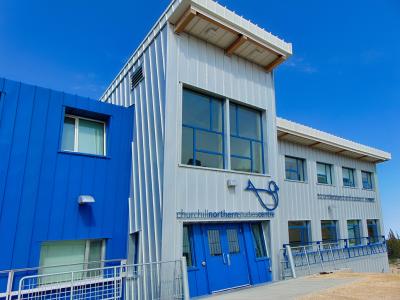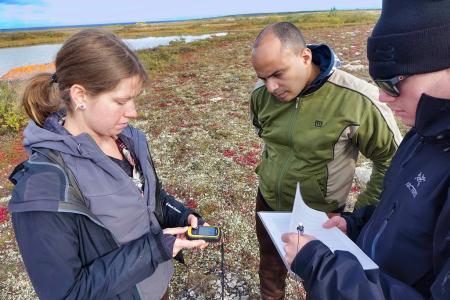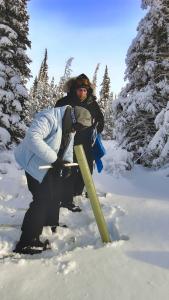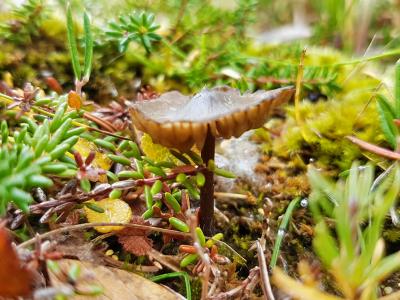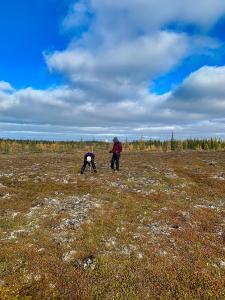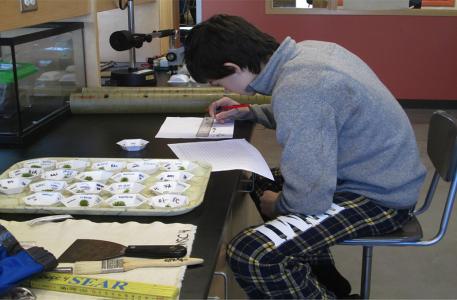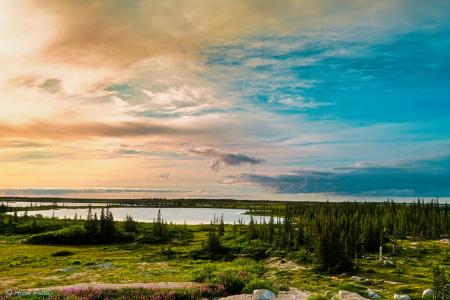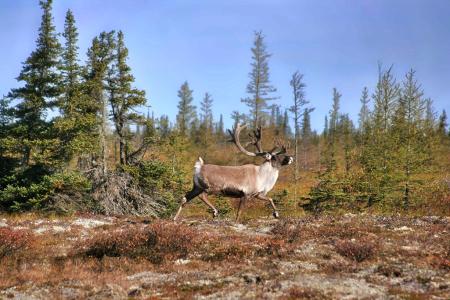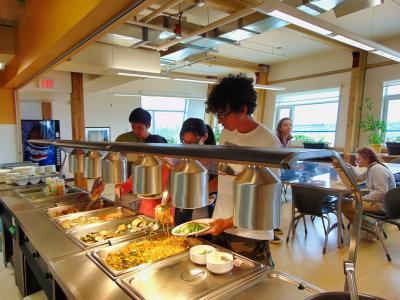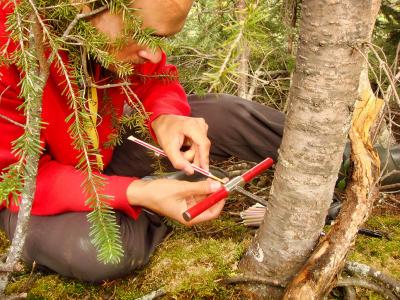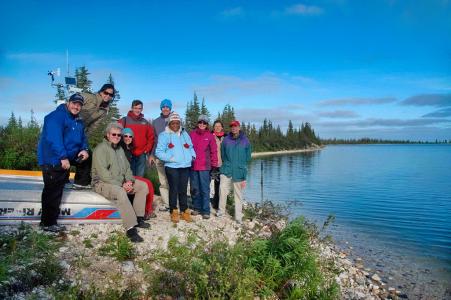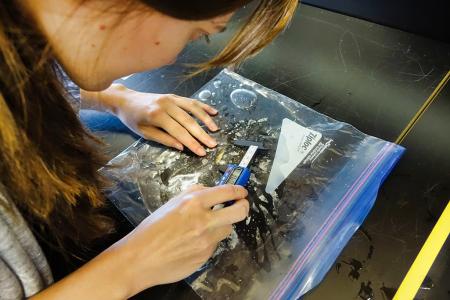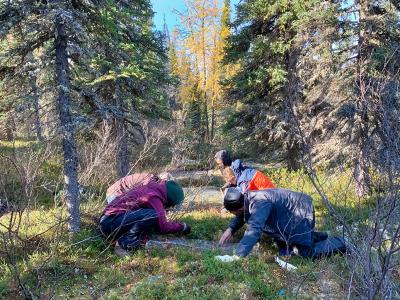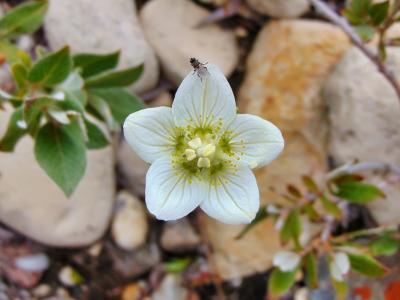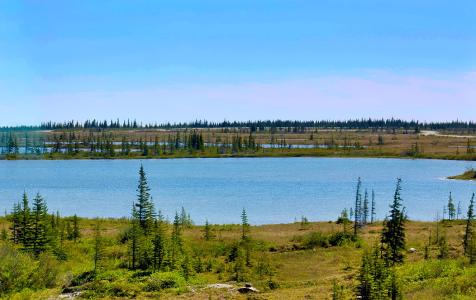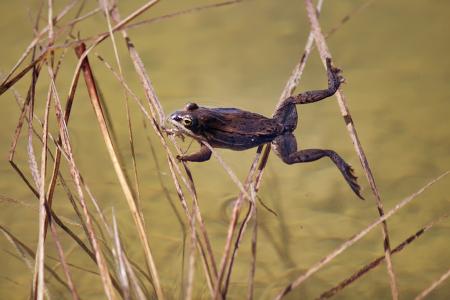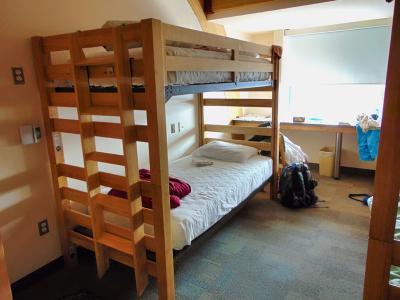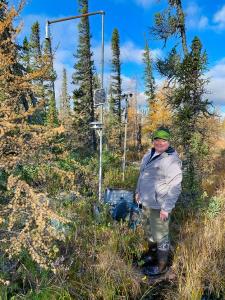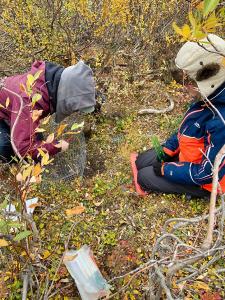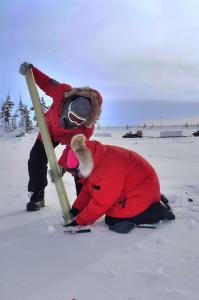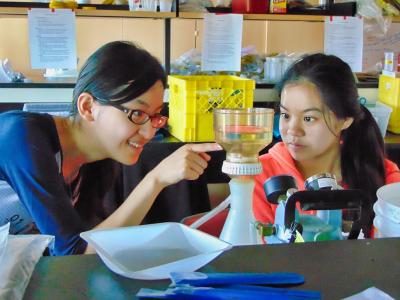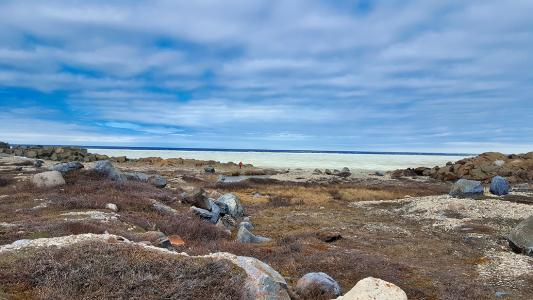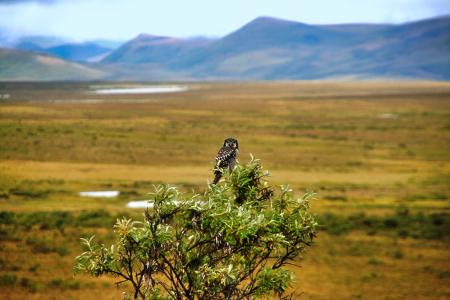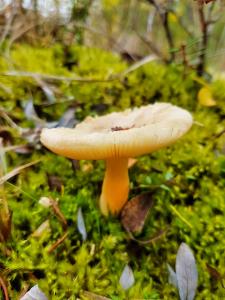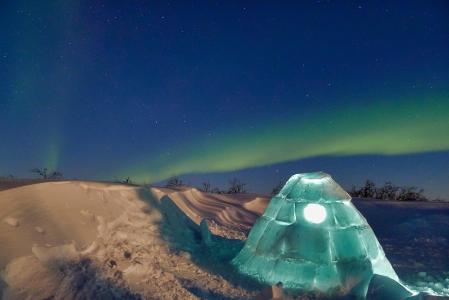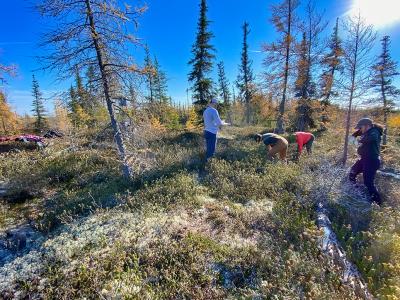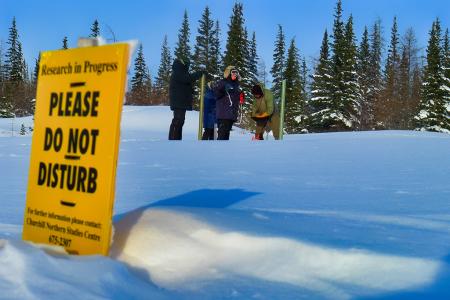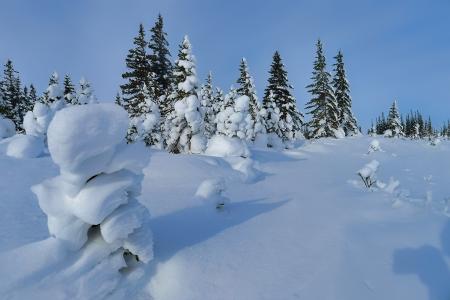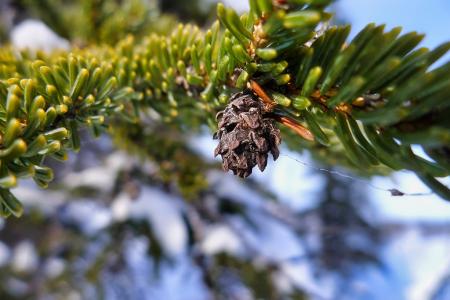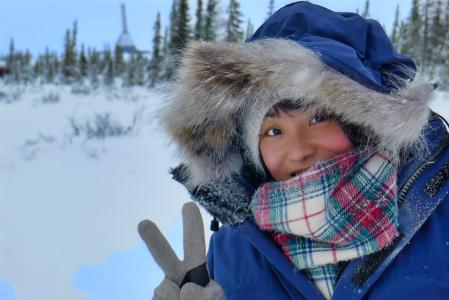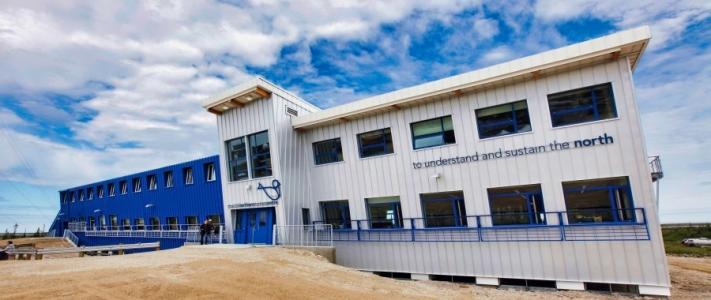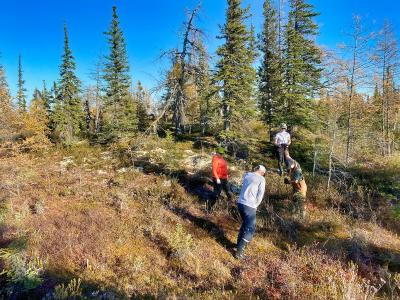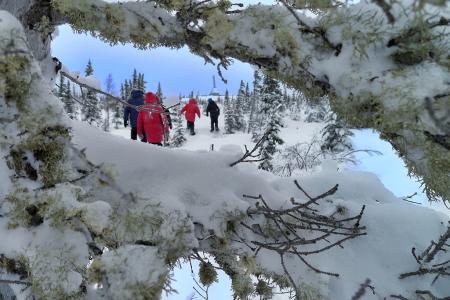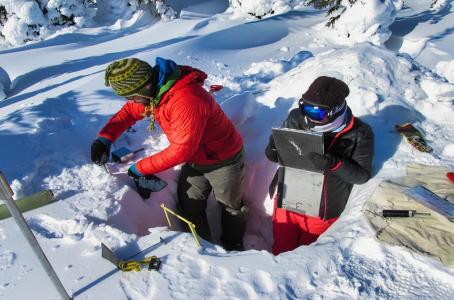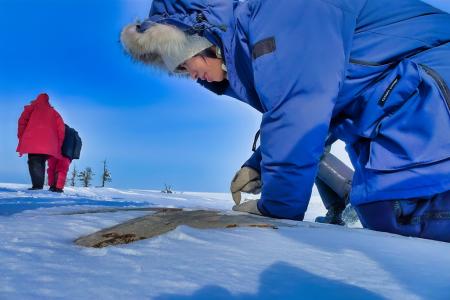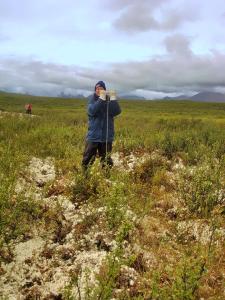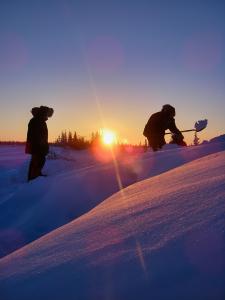.
Please read the following information before leaving for your expedition.
It provides the most accurate information available and will likely answer any questions you have about the project. You may also reach out to your Program Coordinator with any questions you may have.
Click on the images to view full size!
COVID-19 Safety
Please test for COVID-19 before traveling to your expedition; do not travel if you have tested positive, and call Earthwatch right away for the next steps. Visit earthwatch.org/covid-19 for more information on how you can help reduce the risk of COVID-19 impacting your expedition.
The Research
At the Arctic’s edge, we can measure the evidence of climate change: shrinking areas of polar sea ice, retreating glaciers, and less extensive winter snowpack that also melts earlier (ACIA, 2004; IPCC, 2023; SWIPA, 2017). Biological evidence of warming is also mounting. For example, more trees have begun to grow at the northern treeline, and different plant communities are appearing. Northern ecosystems are changing (Bonan et al., 1992; Chapin III et al., 2005; Harsch et al., 2009). Over the next few decades, scientists expect to observe the greatest effects of global warming at high latitudes. In many areas, global warming estimates exceed a 4°C (7.2°F) increase in average air temperature by 2100 relative to the 1986–2005 mean (IPCC 2023). They are predicted to increase by as much as 10°C (18.0°F) in the Arctic (IPCC, 2014). Churchill, on Canada’s Hudson Bay, has warmed approximately 2°C (3.6°F) since record-keeping began in the 1880s, though about 75% of that warming occurred since 1980.
On a global scale, the position of the circumboreal treeline is determined by temperature. However, local treeline positions are modified by frost damage, winter desiccation, and a host of other factors. Assessing the effects of site-specific variables, which could confound the influence of increasing temperatures, is necessary.
Permafrost—ground that remains frozen for more than a year—holds crucial clues to what global warming might entail. It underlies 24% of the earth's surface, including vast areas of Russia, Canada, China, and Alaska. An estimated 50% of the world’s terrestrial carbon is locked up in permafrost (Tarnocai et al., 2009).
Climate Change at the Arctic's Edge
Research Aims
Operating out of the Churchill Northern Studies Centre (CNSC), our main research goal has been to establish an environmental monitoring program to collect baseline quantitative data on climate-related changes in northern ecosystems. Along with the long-term monitoring of environmental conditions, we also conduct experiments to examine the processes occurring more closely in these subarctic conditions. You help obtain large numbers of samples over a short period and are vital to the success of the monitoring and experimental programs. People depend on the health and integrity of the natural world for food, income, and other resources, so collecting such data is vitally important. Locally, many of the residents of Churchill, our nearest neighbors, depend on ecotourism for their livelihood, and our research can inform better policies for preserving the ecosystem that supports them in addition to its global resonance.
This project focuses on three of the global warming-related changes scientists have observed: thawing permafrost, shift of the treeline to the north, and declining snow depth. We have established 11 long-term environmental monitoring sites along a line extending from the boreal forest into the arctic tundra to measure a set of key ecosystem components. These include components of the environment like snow conditions, ground temperature, depth of thawing, and soil carbon, as well as the biological components of the ecosystem, like trees and shrubs, frogs, and fish. At our monitoring sites, automated microclimate stations—which monitor the state of permafrost and active layer—operate year-round. Through repeated probing and coring, we also monitor permafrost and the active layer as part of our fieldwork. We sample and analyze the snowpack in mid-winter. In the lab, we analyze needle desiccation to determine the amount of damage to the cuticles on the needles during the harsh subarctic winter.
Monitoring the treeline by recording the presence of seedlings, saplings, and trees is another big component of this project. We focus on the treeline because minor environmental changes can have big ecological impacts on it. For example, warmer growing seasons can lead to more viable tree seeds and higher germination success, which means more trees grow further into the tundra—thus changing where the treeline lies. Within the forest-tundra zone, buds and leaves are exposed to colder temperatures and higher amounts of wind-blown snow abrasion. Wind-blown snow can thin or remove the waxy cuticle covering needles, resulting in excessive water loss and needle mortality, reducing the plant’s photosynthetic capability during the following growing season. Furthermore, insufficient cuticle maturation in the summer can lead to excessive winter moisture loss. Depending on the intensity, duration, and variability, cold and windy conditions impair vital functions and can set the distributional limits of plant species. However, conflicting results from other studies warrant further research.
The research also focuses on isolated wetlands—bodies of water with highly variable biological and hydrological characteristics that make up about 40% of the surface area in the Hudson Bay Lowlands (HBL) landscape. Because of the temporary character of some of these wetlands, the aquatic organisms differ from those of larger and deeper permanent bodies of water. One important difference is that they usually lack predators such as larger fish and invertebrates, a significant predatory component in aquatic systems. As a result, many organisms have developed specific life histories to take advantage of the characteristics of the wetland, and as the climate changes, so too does the character, chemistry, and species habitat within these wetlands.
Climate Change at the Arctic's Edge
How You Will Help
You’ll get the chance to help with both field and lab research. The time you spend at each will vary with the season; however, you should expect to spend about 50% of your time at the research sites and the remainder in the lab. Depending on the season, you may help set up and monitor equipment and collect data on features of the snowpack, permafrost, and soil; the occurrence of vascular plants, lichens, and mosses; wetland water quality; amphibian tadpole metamorphosis; fish behavior; and annual growth rings of trees.
SNOWPACK STUDIES (February)
Assignments for the winter team will include snowpack descriptions, snow sampling, and lab processing of samples. Outdoor activities depend on light and weather conditions; winter can be extremely physically demanding. Project staff can help organize gear rental for participants, including parkas, pants, mitts, and boots, but participants will be required to bring their own liner gloves and headgear. Trips in the qamutiks (sleds pulled behind snowmobiles) can be rough, cold, and uncomfortable, but the winter landscape will leave you breathless.
WETLAND STUDIES (June and September)
Summer teams (June) will focus on the diverse wetland environments that make up 40% of the land cover in this region. Fall teams (September) will also contribute to this work. Continued long-term monitoring has highlighted the importance of hydroperiod in the wetlands to species compositions during the summer months. The inclusion of experimental approaches to the wetland component of the research program has allowed for the examination of processes that will assist in explaining the natural variation occurring in the landscape. You’ll don waist-high waders to collect species and water quality data from natural shallow tundra ponds and wetlands. You may also participate in mesocosm experiments in outdoor stock tanks. The project will provide neoprene waders and gloves for fieldwork.
TREELINE STUDIES (September)
For this research, you will focus on the physical and biological characteristics of the environment. You’ll study 1) the growth, sexual reproduction, and survivorship of treeline trees and 2) the winter injury of evergreen needles. In addition to ongoing monitoring of natural seedling establishment and survival in the field, seeding experiments will be conducted as part of the Global Treeline Range Expansion Experiment (G-TREE). G-TREE is a globally distributed collaborative project aimed at testing the generality of mechanisms driving boundaries of tree distribution at the treeline (treelineresearch.com/). Soil sampling, permafrost coring, thaw depth measurements, and vegetation sampling could be on the task list of a given team. Equipment for air and ground temperature measurements will be maintained, and cover values for shrubs and trees will be estimated. You will use probes to measure thaw depth and record standard soil characteristics, including organic matter, moisture content, and pH. The team may also assist in sampling the total above-ground biomass from plots within each site.
Climate Change at the Arctic's Edge
Life in the Field
This expedition will provide plenty of learning opportunities. You may hear talks on local permafrost landforms, the ecology of polar bears and whales, species migration, wetland diversity, the project's significance to the community, and climate change monitoring in general.
Depending on your team’s particular tasks, you’ll also hear practical talks on snow pit measurements, plant species identification, wetland structure, sampling techniques, and monitoring and census techniques. You will also learn about the concepts behind the sampling methodology and the use of various equipment.
While you’ll spend most of your time on research tasks, you’ll always have the chance to ask questions, enjoy the scenery, and take in the majesty of the northern treeline. In this pristine environment, there are endless opportunities to view wildlife and plants that are rarely seen. CNSC was established in 1976 to facilitate research, and you will have the opportunity to interact with many other scientists conducting research in the area. It is not uncommon for participants to sit at a cafeteria table with scientists and talk directly with them about their studies. These researchers are also likely to give informal lectures during which in-depth discussions can carry on for hours. You will be amidst an intellectual environment unique to a center like CNSC.
ITINERARY
Weather and research needs can lead to changes in the daily schedule. We appreciate your cooperation and understanding.
- Day 1: Introduction and orientation, starting gradually to enable participants to recover from travel. A meeting will outline the team's objectives, methods, and safety guidelines and provide a preliminary schedule. After this, the team will normally take a brief walk to become familiar with the site and test outdoor gear.
- Day 2: Equipment and training demonstrations. If this is completed in the morning, the team will practice field methods in the afternoon.
- Days 3–10: Each day will begin with a briefing to outline the day’s activities. At least half of each day will be spent at the research sites collecting data, while the remainder will be used for sample processing and data entry. Depending on the tasks, we might make an evening trip to catch the sunset or take other excursions. There will typically be an evening briefing to review the day’s activities, followed by a lecture, lab, or data entry work. On the last evening we’ll have a wrap-up seminar with an overview of the data, comments, recommendations, and discussion about the significance of your contributions to the overall research picture.
- Day 11: Travel Day
MONEY MATTERS
LOCAL CURRENCY: Canadian Dollar (CAD)
PERSONAL FUNDS: Optional recreational excursions may be offered during the expedition, which the participant must cover. See details below under ‘Recreational Time.’
RECREATIONAL TIME
Usually, on the fifth or sixth day of the expedition, the team will have a recreational day (the exact day will depend on weather and research activities). June and September teams will have the opportunity to visit the town of Churchill, where you may participate in a number of organized activities. These are dependent on availability but may include whale watching (ONLY available in June; approx. $120–190 CAD, depending on the boat and number of people); a tour of Fort Prince of Wales, a national historic site (approx. $115 CAD, including the boat trip across the Churchill River); river kayaking ($190 CAD); browsing through the Eskimo Museum ($10 CAD donation); a regional natural history tour (approx. $110 CAD); or simply souvenir shopping. The winter team (February) may also have the opportunity to visit the town of Churchill and participate in an authentic dog sledding adventure tour (approx. $130 CAD). All activities are seasonal and weather-dependent, and staff at the CNSC will help coordinate these activities with the local operators.
Climate Change at the Arctic's Edge
Accommodations and Food
* Please note that not every expedition has couples’ or singles’ accommodations available. Please call or email Earthwatch to check availability before reserving your space(s) on the team.
The Churchill region is polar bear country, and significant safety issues exist whenever we are out of doors. The CNSC is 23 kilometers (14 miles) east of the town of Churchill. Consequently, participants must be accompanied by a CNSC staff member or the scientist, who will carry bear deterrents before being allowed to go out of doors during free time. CNSC is a non-smoking facility.
SLEEPING
You’ll stay in dormitory rooms with up to four same-gender participants in bunk beds. Due to the dormitory-style setup and limited room availability with multiple user groups at CNSC, single/couple rooms cannot be guaranteed.
* Earthwatch will respectfully and without judgment honor each person’s assertion of gender identity. For both teen and adult teams, where logistics dictate single-sex accommodations or other facilities, participant placements will be made in accordance with the gender identity the participant specified on their Earthwatch Participant form and/or preferences indicated in discussions with Earthwatch.
IGLOOS
Winter Team Only: The optional activity of building igloos may be offered. This requires cutting, lifting, and placing 20- to 30- kilogram (45- to 65-pound) blocks of snow that should not be dropped, and at 70 x 50 x 15 centimeters (28 x 20 x 6 inches), each block can be awkward to maneuver. This task requires a lot of energy. Fortunately, there are usually enough people participating to share the heavier tasks.
BATHROOMS
The CNSC water is trucked to the facility, so we practice water-saving measures, including composting toilets and encouraging all visitors to take short showers. There is running water throughout the facility, which includes flush toilets and individual shower rooms. Laundry is available for a fee of $6 CAD per load (washing detergent is included; coin-operated).
ELECTRICITY
The CNSC has reliable electricity (outlet types A or B, 120 volts, 60 hertz). You should bring along any necessary converters and adapters.
PERSONAL COMMUNICATIONS
There is a cell phone booster in the CNSC's atrium for calls, but it is best not to rely on cell coverage throughout the building or at field sites. Wireless internet is available throughout the CNSC at no additional charge, and Wi-Fi calling is a possibility with some cell phones. There will be a computer available for participants to use in their free time, but it is recommended that participants bring a laptop or tablet for personal use if possible.
Please note: Earthwatch encourages volunteers to minimize outgoing calls and immerse themselves in the experience; likewise, family and friends should restrict calls to urgent messages only. Emergency communications will be prioritized.
DISTANCE TO THE FIELD SITE
All research sites are within 40 minutes of the CNSC. Transport is by van or SUV, except in winter, when participants are transported in qamutiks (sleds pulled behind snowmobiles).
FOOD AND WATER
Accredited cooks prepare all the meals in the kitchen. Food is served cafeteria style, and all CNSC users share the dining area. Participants assist with after-meal cleanup. Meals are varied and usually include a choice of salads, desserts, and a vegetarian dish. We also have fresh bread and evening snacks.
TYPICAL MEALS
The following are examples of foods you may find in the field. Variety depends on availability. We appreciate your flexibility.
- Breakfast: Eggs, bacon, toast, porridge, pancakes, French toast, sausages, fresh/dried fruit, yogurt, muffins, cold cereals, toast
- Lunch: Soup, sandwiches, macaroni and cheese, grilled cheese sandwiches, burgers, French fries, fruit
- Dinner: Meatloaf, spaghetti, roast beef, turkey, lasagna, fish, potatoes, pork chops, pizza, chicken, salads, Jell-O, cake, pie, fresh fruit, cooked vegetables, stew
- Snacks: Leftovers, fruit, cookies, cereal, popcorn
- Beverages: Coffee, tea, hot chocolate, water
- Water: All water is drinkable. Cold, fresh water is always available for free in the cafeteria.
SPECIAL DIETARY REQUIREMENTS
Please alert Earthwatch to any special dietary requirements (e.g., diabetes, lactose intolerance, nut or other food allergies, vegetarian or vegan diets) as soon as possible and note them in the space provided on your participant forms.
Special diets are not guaranteed to be accommodated. However, vegetarians, lactose intolerance, gluten intolerance, and other allergies can generally be accommodated with prior notification.
Climate Change at the Arctic's Edge
Project Conditions
The following information is as accurate as possible, but please remember that conditions may change.
Most of the sites are gravel, peat over sand, or peat over permafrost. In general, the area ranges from flat to hummocky. The wetlands have standing surface water for the most part, and some have mucky bottom sediments. On average, temperatures at Churchill over the summer range from -5 to 28°C (23°F to 82°F). There is very little humidity, except during periods of fog when the wind comes off the Bay, and rainfall during the summer is usually around 2.5 inches (6 cm) per month. Spring begins in June with the end of snowfall and melt, while late August is the beginning of autumn and brings cooler temperatures. The average temperature, however, is often misleading since it can feel like autumn in the morning and the height of summer in the afternoon following a shift in the wind.
The winter is long and dominated by extremely cold arctic air masses, often with strong winds. In mid-winter, temperature becomes irrelevant (usually just -40°C/-40°F), and wind chill values are used. In February, the wind chill often exceeds -45°C (-50°F), and exposed skin will freeze in seconds. The upside is that there are no insect pests at this time of year, and the long nights provide an amazing opportunity to view the northern lights.
GENERAL CONDITIONS
Please visit wunderground.com and search your project location for weather and region-specific information.
Climate Change at the Arctic's Edge
Essential Eligibility Requirements
All participants must be able to:
- Wear all protective equipment recommended or required by industry standards, which is especially important for the winter team. If you bring gear that the staff feels is inappropriate, you may have to rent gear at your own expense. Please read the section for the winter team in the Packing List.
- Enjoy being outdoors all day in all types of weather, in the potential presence of wild animals and insects.
- Tolerate temperatures as high as 28°C (82°F) and as low as -55°C (-67°F) in winter.
- Carry personal daily supplies, such as lunch, water, and some small field equipment, of up to nine kilograms (20 pounds).
- Repeatedly get low enough to undertake ground-level activities such as soil sampling, permafrost coring, frost probing, vegetation sampling, and fish and amphibian trapping, up to 12 hours daily.
- Traverse varying terrain from level hard surfaces to undulating, hummocky ground. Total time hiking is up to four hours per day.
- Promptly alert project staff about any injuries or discomfort (bruising, difficulty breathing, etc.) as soon as it occurs.
- Winter Team Only: During transit, travel in a seated, upright position within a qamutik sled, which can sometimes be bumpy. This can be uncomfortable for individuals with back problems.
- Winter Team Only: Maintain a high enough calorie intake to keep up with the increased energy demands of working in frigid temperatures and deep snow.
- Follow verbal and/or visual instructions independently or with the assistance of a companion.
- Take an active role in one’s safety by recognizing and avoiding hazards if and when they arise (including, but not limited to, those described in Earthwatch materials and safety briefings). Always comply with project staff instructions and recommended safety measures.
- Be able to effectively communicate with the staff if they are experiencing distress or need assistance.
- Be able to get along with a variety of people from different backgrounds, often in close proximity, for the duration of the team.
- Be comfortable being surrounded by a language and/or culture that is not your own.
Climate Change at the Arctic's Edge
Health and Safety
EMERGENCIES IN THE FIELD
Field staff members carry handheld radios to communicate with CNSC, from where someone would call the hospital for guidance in an emergency. A vehicle is always available in the field, and several first-aid kits are maintained at CNSC. Anyone with a medical emergency will be evacuated directly to the hospital in Churchill. If the situation is severe, a helicopter can transport the injured person. In the event of a dangerous encounter with a polar bear, the animal will be deterred using standard procedures, and the team will leave the area and report the incident to CNSC.
Earthwatch has a 24-hour, 7-day-a-week emergency hotline number. Someone is always on call to respond to messages that come into our live answering service.
IMMUNIZATIONS & TRAVEL VACCINATIONS
Please be sure your routine immunizations are up to date (for example, diphtheria, pertussis, tetanus, polio, measles, mumps, rubella, and varicella) and that you have the appropriate vaccinations for your travel destination. Medical decisions are the responsibility of each volunteer and their doctor. Visit the Center for Disease Control and Prevention or the World Health Organization for guidance on immunizations.
If traveling from countries or regions where yellow fever is endemic, you must have a certificate of vaccination.
Staying up to date with your COVID-19 vaccinations, including receiving booster doses, as applicable, is strongly encouraged.
Climate Change at the Arctic's Edge
Project Risks and Precautions
TRANSPORTATION
The road is gravel, and its condition varies depending on the weather. In winter (Team 1), whiteouts and icy roads make driving conditions more difficult. The winter team will be transported into the field on qamutiks (sleds pulled behind snowmobiles). There are no safety belts on these sleds. The snow is quite hard, and the qamutiks offer no cushioning. You may wish to bring your own padding for travel while in the qamutiks (see the section for winter team in the Packing List). All drivers hold licenses required by the Canadian government, and vehicles meet provincial safety standards by adding shortwave radios to talk to the base.
HIKING
Hiking along the trails to the research sites varies from unstable ground with tall shrubs to open, hard ground. Trail sections can also be very wet with deep holes (at times, the depth exceeds the height of participants’ rubber boots). Teams working in wetlands will wade in standing water up to 75 cm in depth using neoprene waders. Waders and rubber boots are provided on-site.
TERRAIN
All participants will be hiking in the field, and there is a risk of strains, sprains, and breaks due to falls. The trails are well marked, and the participants will be traveling as a group, but the footing can be slippery, especially with frost, light snow, or rain. You must have rubber boots due to sections of wetlands at several sites and tall shrubs that can restrict movement at some sites.
ANIMALS
The Churchill region has a large concentration of polar bears. Consequently, the teams must be near a vehicle equipped with a radio and armed with suitable deterrents at all times. Project staff will have several polar bear deterrents, ranging from noisemakers to firearms. CNSC has thorough safety standards in place for the use and management of firearms. For safety considerations, avoiding being in the presence of firearms will not be possible. Participants will not handle or use the firearms. The Earthwatch scientist and other field staff (NOT participants) will carry deterrents.
INSECTS
Mosquito and blackfly populations are very dense in July and August. They are present in June and September as well, but less intense. There is some risk of West Nile Virus in the Churchill region, although cases are much more prevalent in southern Manitoba. Take precautions to prevent mosquito bites by using insect repellent and wearing long-sleeved shirts, bug jackets, or head nets while in the field. Black flies bite and inject an anticoagulant, which is generally very irritating. Bring an antihistamine if you suspect you might have an allergic reaction to their bites.
CLIMATE/WEATHER
During winter and fall, there are risks of hypothermia, frostnip, frostbite, extreme chapping and cracking of lips and hands, other cold-related injuries, and cold-caused damage to personal gear. The risk of cold-related injury increases in those with heart and lung disease and other conditions that reduce or impair circulation to the skin and extremities. Certain medications can exacerbate the risks of cold-related injury.
The sun can be quite intense in all seasons. Even on an overcast day, you are at risk of sunburn; bring plenty of good-quality lip, sun, and wind block. Also, the environment is dry year-round, so drink plenty of water to avoid dehydration.
DISTANCE FROM MEDICAL CARE
The nearest hospital is 23 kilometers (15 miles) from the project site, and it may take up to an hour to arrange transport and reach the hospital. If you have a chronic condition that could require immediate medical care (e.g., heart conditions, kidney problems, severe asthma, etc.), or if you are pregnant, please discuss your participation on this expedition with your physician.
DISEASE
Traveler’s diarrhea affects many international travelers. Please see the U.S. Centers for Disease Control and Prevention (cdc.gov) or the World Health Organization (who.int) websites for more information on this condition and how to avoid it.
A note on vaccinations and treatment:
West Nile Virus: West Nile is a mosquito-transmitted virus. Several cases of West Nile virus are reported each year from southern Manitoba. There is a low risk of contracting West Nile virus in northern Manitoba, where the Churchill teams take place—though participants are always advised to take precautions to prevent mosquito bites when working outdoors.
COVID-19 DISEASE RISKS
COVID-19 remains an evolving risk to communities and individuals around the world.
Earthwatch strongly encourages you to stay up to date with your vaccinations, including receiving booster doses if available, and to continue to limit your exposure before your program, such as wearing a mask during travel and frequently washing your hands. Persons with a higher risk of severe illness from COVID-19 should consult with their healthcare provider before participation.
If you, or another person on site, display symptoms of illness or test positive for COVID-19, you may be required to wear a mask, test for COVID-19, seek medical advice, isolate/quarantine on- or off-site, cease or limit participation in program activities, and/or take other precautions. If local conditions or recommendations from authorities change, additional requirements may be implemented.
If you must isolate or depart from a program due to COVID-19 or other illness, you will not be entitled to a refund of the contribution for the program, nor any expenses resulting from your participation in the program or a disruption of your travel plans. We strongly encourage you to purchase travel insurance that will cover this eventuality.
Climate Change at the Arctic's Edge
Travel Planning
RENDEZVOUS LOCATION
Churchill Airport or train station, Manitoba, Canada
Note: Please plan for one or more extra travel days on either end of the expedition.
Flights to Churchill originate from Winnipeg, Manitoba. Plane service is offered only through Calm Air. Due to international flight schedules, most participants must arrive in Winnipeg a day early and spend the night in a local hotel before catching their Calm Air flight to Churchill the next day. Similarly, an overnight in Winnipeg on the return trip is advised to ensure you can make your onward connection should you be delayed. Train travel to Churchill is also possible from several Canadian destinations and is offered through VIA Rail.
Flight & train schedules can be variable. Participants may also need to overnight in Churchill before and/or after the expedition begins. The participant must arrange and pay for any accommodations outside of the expedition dates.
Your Earthwatch Expedition Logistics Document will provide specific travel planning details. Once you enroll, you can find this document in your MyEarthwatch Portal. Please do not book travel arrangements—such as flights—until the Expedition Logistics Document matching the current year has been published to your portal account.
ABOUT YOUR DESTINATION
Earthwatch strongly recommends that travelers investigate their destination before departure. Familiarity with the destination’s entry/exit requirements, visas, local laws, and customs can ensure smooth travel. The U.S. Department of State's Traveler’s Checklist and Destination Guides are helpful resources. For LGBTI travelers, the U.S. Department of State's LGBTI Travelers page contains many helpful tips and links.
COUNTRY AND PROJECT ENTRY REQUIREMENTS
You are responsible for reviewing and abiding by your destination's entry/exit requirements.
Entry visa requirements differ by country of origin, layover, and destination and do change unexpectedly. For this reason, please confirm your visa requirements at the time of booking and again 90 days before travel. Please apply early for your visa (we recommend starting six months before the start of your expedition). Refunds will not be made for volunteers who cancel due to not obtaining their visa in time to meet the team at the rendezvous. You can find up-to-date visa requirements at the following website: travisa.com.
If a visa is required, participants should apply for a TOURIST visa. Please note that obtaining a visa can take weeks or even months. We strongly recommend using a visa agency to expedite and simplify the process.
Climate Change at the Arctic's Edge
Resources
ARTICLES
- Huntington, H., G. Weller, E. Bush, T.V. Callaghan, V. Kattsov, and M. Nuttall. “Chapter 1: An Introduction to the Arctic Climate Impact Assessment.” In Arris, L. (ed.)
- Arctic Climate Impact Assessment: Scientific Report, 2-19. Fairbanks: ACIA Secretariat and Cooperative Institute for Arctic Research. Available at: http://www.acia.uaf.edu/pages/scientific.html
- Overpeck, J.T., K. Hughen, D. Hardy, R. Bradley, R. Case, M. Douglas, B. Finney, K. Gajeswski, G. Jacoby, Jennings, S. Lamoureux, A. Lasca, G. MacDonald, J. Moore, M. Retelle, S. Smith, A. Wolfe, and G. Zielinski. “Arctic environmental change of the last four centuries.” Science 278 (1997): 1251-1256.
BOOKS
- Alley, R. The Two-Mile Time Machine: Ice Cores, Abrupt Climate Change, and Our Future. Princeton: Princeton University Press, 2002.
- McGhee, R. Ancient people of the Arctic. Vancouver: UBC Press, 1996.
- Stirling, I. Polar Bears: The Natural History of a Threatened Species. Markham, ON: Fitzhenry and Whiteside, 2011.
- Brandson, L.E. Churchill, Hudson Bay: A Guide to Natural and Cultural History. Churchill: The Eskimo Museum, 2011.
- Bennett, J. A Global Warming Primer. Boulder: Big Kid Science, 2016.
- McGoogan, K. Ancient Mariner. Toronto: HarperCollins Publishers Ltd., 2003.
FIELD GUIDES
- Jehl, J.R. Birdlife of the Churchill Region: Status, History, Biology. Victoria, B.C.: Trafford Publishing, 2004.
- Johnson, K.L. Wildflowers of Churchill and the Hudson Bay Region. Winnipeg: Manitoba Museum of Man and Nature, 1987.
PROJECT-RELATED WEBSITES
- Steve Mamet Webpage
- Churchhill Northern Studies Centre
- Climate Change at the Arctic's Edge—Facebook
- Climate Science Information
LITERATURE CITED
- ACIA, 2004. Arctic Climate Impact Assessment: Impacts of a Warming Arctic. Cambridge University Press, Cambridge, UK, 1042 pp.
- Bonan, G.B., Pollard, D. and Thompson, S.L., 1992. Effects of boreal forest vegetation on global climate. Nature, 359: 716-718.
- Chapin III, F.S. et al., 2005. Role of land-surface changes in Arctic summer warming. Science, 310: 657-660.
- Diffenbaugh, N.S. and Field, C.B., 2013. Changes in Ecologically Critical Terrestrial Climate Conditions. Science 341: 486-492.
- Harsch, M.A., McGlone, M.S. and Duncan, R.P., 2009. Are treelines advancing? A global meta-analysis of treeline response to climate warming. Ecology Letters, 12: 1040-1049.
- IPCC 2013 Climate change 2013: the physical science basis. Contribution of Working Group I to the fifth assessment report of the Intergovernmental Panel on Climate Change.” New York: Cambridge University Press. Available here.
- IPCC, 2014. Climate Change 2014: Synthesis Report. Contribution of Working Groups I, II, and III to the Fifth Assessment Report of the Intergovernmental Panel on Climate Change [Core Writing Team, R.K. Pachauri and L.A. Meyer (eds.)]. IPCC, Geneva, Switzerland, 151 pp.
- Overpeck, J.T., Hughen, K., Hardy, D., Bradley, R., Case, R., Douglas, M., Finney, B., Gajewski, K., Jacoby, G., Jennings, A., Lamoureux, S., Lasca, A., MacDonald, G., Moore, J., Retelle, M., Smith, S., Wolfe, A., and Zielinski, G., 1997. Arctic environmental change of the last four centuries. Science 278: 1251-1256.
- Smith, W. K., Germino, M.J., Johnson, D.M., and Reinhardt, K., 2009. The altitude of alpine treeline: A bellwether of climate change effects. Botanical Review 75:163-190.
- Tarnocai, C., Canadell, J.G., Schuur, E.A.G., Kuhry, P., Mazhitova, G., and Zimov, S., 2009. Soil organic carbon pools in the northern circumpolar permafrost region. Global Biogeochemical Cycles 23: doi:10.1029/2008GB003327.
- Vavrus, S.J., Holland, M.M., Jahn, A., Bailey, D.A., and Blazey, B.A., 2012. Twenty-First-Century Arctic Climate Change in CCSM4. Journal of Climate 25: 2696-2710.
Climate Change at the Arctic's Edge
Sign up for the Earthwatch Newsletter
Be the first to know about new expeditions, stories from the field, and exciting Earthwatch news.
.
.
.
